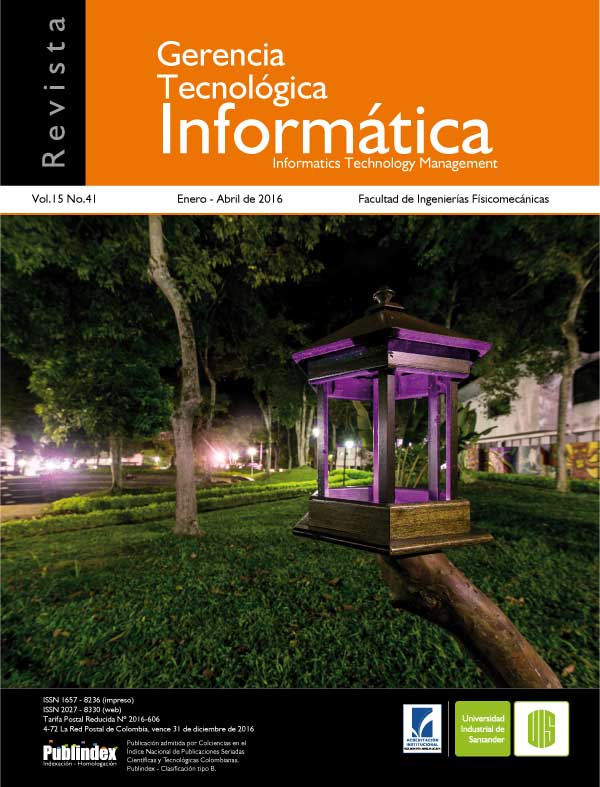MODELO BASADO EN SERVICIOS WEB PARA LA COMPARACIóN INTELIGENTE DE PROCESOS DE NEGOCIO
Published 2016-11-29
How to Cite
Abstract
El objetivo principal del artículo es proponer un modelo inteligente de comparación de procesos de negocio, para la propagación de cambios en variantes de procesos. El sistema fue desarrollado teniendo en cuenta dos componentes: una plataforma tecnológica basada en servicios web soportada por un sistema multiagente y un mecanismo de inferencia sensible al contexto. La validación del sistema se realizó sobre un caso de estudio relacionado con el proceso de admisiones a programas de educación superior en la Universidad Nacional de Colombia. Se puede concluir que la comparación de variantes puede verse afectada por información del contexto y que un enfoque distribuido soportado por servicios web y agentes inteligentes, facilita el uso del mecanismo de inferencia.
PALABRAS CLAVES: Procesos de negocio, variantes, Comparación inteligente, Arquitectura orientada a servicios web, Servicios Web.
Downloads
References
- (Akkiraju e Ivan, 2010) Akkiraju R. e Ivan A. (2010). Discovering business process similarities: an empirical study with SAP best practice business processes. 8th International Conference on Service-Oriented Computing. Vol. 6470 of LNCS, 2010, pp. 515–526.
- Becker M. y Laue R. (2012). A comparative survey of business process similarity measures. Computers in Industry, Volume 63, Issue 2, February 2012, Pages 148-167, ISSN 0166-3615.
- Buijs J. y Reijers H. (2014). Comparing Business Process Variants using Models and Event Logs. Enterprise, Business-Process and Information Systems Modelingv Volume 175 of the series Lecture Notes in Business Information Processing pp 154-168.
- Carvalho J., Santoro F. y Revoredo K. (2015). A method to infer the need to update situations in business process adaptation. Comput. Ind. 71, C (August 2015), 128-143.
- Conforti R., Dumas M., La Rosa M., Maaradji A., Nguyen H., Ostovar A. y Raboczi S. (2015). Analysis of Business Process Variants in Apromore. 13th International Conference on Business Process Management (BPM’15)
- Dey, A. “Understanding and using context”. (2001). Journal Personal and Ubiquitous Computing, 5(1), pages 4–7.
- Dijkman R., Dumas M., van Dongen B. y Mendling J. (2011). Similarity of business process models: metrics and evaluation. Information Systems 36 – 2011. 498–516.
- Dijkman R., La Rosa, M. y Reijers, H. (2012) Managing Large Collections of Business Process Models - Current Techniques and Challenges, Computers in Industry, Vol. 63 No. 2.
- Döhring M., Reijers H. y Smirnov S. (2014). Configuration vs. adaptation for business process variant maintenance: An empirical study, Information Systems, Volume 39, January 2014.
- Dumas M., La Rosa M., Mendling J. y Reijers H. (2013). Fundamentals of Business Process Management. Springer. [11] Gao, J. y Zhang L. (2009). On Measuring Semantic Similarity of Business Process Models. i-esa, pp.289-293, International Conference on Interoperability for Enterprise Software and Applications.
- Kishore R., Zhang H., y Ramesh R. (2006). Enterprise integration using the agent paradigm: foundations of multi-agent-based integrative business information systems. Decision Support Systems 42(1): 48-78.
- Machado, D., Mendes R., Santoro F. y Pena, G. (2012) Defining context in a business process collaborative elicitation approach. CSCWD 2012: 861-868.
- Mattos, T., Santoro F., Revoredo K. y Tavares V. (2012). Formalizing the situation of a business process activity. Presentado en CSCWD 2012: 128134.
- Morrison E. D., Menzies A., Koliadis M. y Ghose A. K. (2009). Business Process Integration: Method and Analysis. Asia-Pacific Conference on Conceptual Modelling (APCCM 2009).
- Nedbal D. A Process Model to guide the Integration of Business Processes and Services within and across Organizations. (2013). International Journal of Services, Economics and Management, Vol. 5, No. 1, 2013, pp. 154-177.
- La Rosa M., Dumas M., Uba R., y Dijkman R. (2013). Business Process Model Merging: An Approach to Business Process Consolidation. ACM Transactions on Software Engineering and Methodology (TOSEM), 22(2).
- Padgham L. y Winikoff M. (2004). Developing Intelligent Agent Systems: A Practical Guide, John Wiley & Sons, Ltd, Chichester, UK.
- Ploesser K., Peleg M., Soffer P., Rosemann M. y Recker, J. (2009). Learning from Context to Improve Business Processes. BPTrends. January 2009.
- Ploesser K., Recker J. y Rosemann M. (2011). Challenges in the context-aware management of business processes: a multiple case study. ECIS 2011.
- Saidani O. y Nurcan S. (2009). Context-Awareness for Adequate Business Process Modelling. Proceedings of the Third IEEE International Conference on Research Challenges in Information Science 2009.
- UNAL-Universidad Nacional de Colombia. (2015) Manual del Sistema Integrado de Gestión. Disponible en línea: http://www.simegebogota. unal.edu.co/ Accedida: Septiembre 2015.
- Weidlich M. y Mendling J. (2012). Perceived consistency between process models. Information Systems, Volume 37, Issue 2, April 2012, Pages 80-98, ISSN 0306-4379.
- Weidlich M., Mendling J. y Weske M. (2012). Propagating changes between aligned process models. Journal of Systems and Software, Volume 85, Issue 8. Pages 1885-1898, ISSN 0164-1212.
- Wooldridge M. (2009). An Introduction to MultiAgent Systems. John Wiley & Sons. Second Edition.
- Xiang, L. (2007), A Multi-Agent-Based Architecture for Enterprise Customer and Supplier Cooperation Context-Aware Information Systems. Third International Conference on Autonomic and Autonomous Systems (ICAS’07).
- Zhiqiang Y., Remco M. y Dijkman M. (2012) Business process model repositories - Framework and survey. Information & Software Technology, 2012.
